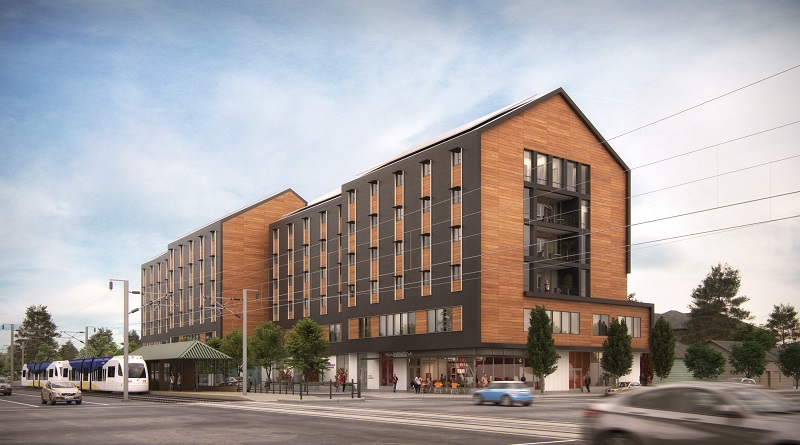New Health & Recovery Center Unites Affordable Housing and Healthcare for Portland
By Roxanne Squires
PORTLAND, Ore. – After competing with multiple architects, Ankrom Moisan Architecture was selected to partner with Central City Concern (CCC) in a quest to design a new Transit Oriented Development (TOD) in the city of Portland.
The six-story, 119,000-square-foot facility will serve as a help and healing center with CCC partnering alongside six Oregon healthcare organizations to combine affordable housing with comprehensive healthcare.
The Eastside Health Center Campus TOD is designed to provide healthcare and housing for people who are medically fragile, recovering from addiction or receiving treatment for mental health issues, while the facility also serves as a new home for the existing Eastside Concern program.
As a part of the city’s efforts to address the prevalence of addiction and overdose among the population, the facility is designed based on a transitioning system for the residents – with designated space for detox as well as opportunity for patients to progressively gain autonomy throughout their rehabilitative process. This will be CCC’s first time fusing urgent care, housing and palliative services all into one facility; counting 175 available housing units altogether.
According to Ankrom Moisan’s website, the design’s goal is to achieve the concept of a “home” with the familiar, gabled rooflines often associated with single family homes; the multifamily, mixed-use building program is aimed to encourage interaction and support among residents. Designing for acoustics to help drown out city noise as well as fresh air, were vital to the “homey” feeling of the facility.
A petite plaza, set back from the sidewalk, creates a deliberate gathering space at the front of the building. The site is also noted for its convenient access given close proximity to the MAX and bus line; connection to mass transit is key to creating and sustaining affordable housing, and vital to providing vulnerable populations access to healthcare and support services, as said by AM.
Furthermore, all utilities are paid for by CCC, keeping a goal in mind to maintain the building’s sustainable framework and to eventually achieve LEED Gold Certification, with solar panels being utilized atop the southern façade of the building’s roof.
The first two floors are comprised of an open-to-the-public clinic, with the first story holding the “living room” of the building, including a teaching kitchen, lounge seating and phone charging stations. The pharmacy, urgent care center, an acupuncture facility, classrooms, a group meeting space, and staff and resident bicycle storage are provided on the first floor as well. These first two floors offer integrated primary care, substance use disorder treatment, domestic violence counseling and wellness services, offering 24/7 clinical support for some of these programs.
The third through fifth floors are a part of the facility’s transitioning system for its residents with personal milestones such as employment and sobriety granting access to the above floors, including the third floor being designated as the first of its private transitional housing, palliative care services and common/kitchen areas.
The fourth and fifth floors consist of single-room occupancy units, with shared showers and kitchens. Finally, the sixth floor extends affordable, long-term studio units to its residents, offering an occupancy of up to two years.
According to Mariah Kiersey, Ankrom Moisan’s principal architect and project manager, AIA, the building has also integrated a locking mechanism combined with a lighting system for each bathroom in response to the concern of patients overdosing inside the facility. The system works to notify whether someone has occupied the bathroom for over ten minutes after locking the door with a simple light turning on above, allowing staff to reach patients in time.
“This facility also makes sure that the homeless aren’t left to perish on the streets after being discharged from the hospital,” Kiersey said, referring to the hospice provided inside the building. “This facility serves as a catalyst project, offering much-needed care to Portland’s highly dense homeless population.”
Construction of the new facility began November 2017; while residents will be allowed to move in May 2019, the grand opening of clinic is scheduled for July 1, 2019.

